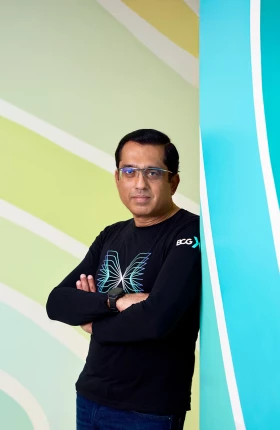In 2025, Verizon launched an innovative upgrade to its customer service program. Deriving its name from its June 24 launch date, Project 624 is only the first step in Verizon’s ambitions of being “the best applied AI company in the world.” The new product utilizes AI-driven tools to enhance the services provided by human agents, significantly upgrading the telecom giant’s customer experience platform and freeing up agents’ time significantly.
Sowmyanarayan Sampath, CEO of Verizon Consumer Group, calls it the company’s “single largest customer experience launch.” He adds, “We want to be unique in the market and set a higher standard for what customer care looks like in telco, but all industries worldwide as well. And for that, we deployed some of the most advanced technology in the world.”
Verizon’s path to growth blends the traditional with the transformative, leveraging industry mergers that demand attention to cultural integration, and innovations in AI and customer experience that push the boundaries of what’s possible. As Sowmyanarayan explains in the following interviews, at the core is culture itself, whether aligning with new partners or elevating every customer interaction, as the engine of innovation, value creation, and lasting growth.
We've invested $200 billion in America over the last seven years, and a lot of that is to drive AI. But it’s connectivity, whether it’s data center capacity to enable mobility, broadband, and cloud. So we have three vectors. All three are going to be value-accretive to us.
AI is top of mind for many CEOs today. How do you see AI driving value for Verizon?
I see AI in three buckets where we capture value. The first is applied AI, where we use AI to improve our operations and our experience. The second is to leverage AI to drive better products, so customers see we have a better product because of AI. The third is how we take part in the AI ecosystem to drive more revenue just from the ecosystem alone.
Where do you start the journey?
The single biggest opportunity for us is customer care. We have probably one of the largest pools of customer care agents in the world, and they do an incredible job every single day answering questions, selling to customers, taking care of customers.
The first opportunity for me is cognitive offload. Our frontline agents carry so much in their heads: the rates, the plans, the technology, the handsets. They have a lot going on in a short period of time. When you pair an agent who has empathy and an emotional connection to customers with data and bring the two together, you get a personalized engine that’s very tough to beat. So that’s how we think customer agents will evolve. I see an environment where the agents will do different things. But the scenario that’s most likely is you take the capacity that’s freed up, which could be as high as 40% or 50% over the next three years, and deploy that in other areas.
Stay ahead with BCG insights on technology, media, and telecommunications
Congratulations on the successful launch of Project 624. It is a major step forward for the entire industry, and Verizon has made a massive investment in creating a customer experience that is market-leading in many ways.
We want to be the best deployed conversational AI tool in the world. That’s our goal.
Agent tech is good. We know how to do it. But conversational AI is the most difficult part of AI, where customers are talking either through chat or through voice, and real-time things are happening to do that. So Project 624 was a massive launch in that space. We did a couple of things. The first and biggest one was an app. We completely redesigned the app from the bottom up. We made it about the customer, but more importantly, we launched the Verizon Assistant, which is the world’s most advanced AI app, in the space that we have. You can check your bill. It can tell you why your bill went up. You want to travel to Italy? It will hook you up with roaming. It can do hundreds of things that typically chatbots have never been able to do, and in the unlikely event it cannot solve a problem, it pushes it to a customer agent who has all the history to do that.
Verizon has partnered with Google to get this done. Can you talk a little bit about Google’s role in making it happen?
We work very closely with Google. Google’s almost like an R&D partner to us. We bring our teams together in a single building and they work together. There’s a lot of AI that we use to route calls and other things. We’ve got maybe 15 other things that we launched, but this is the single biggest CX release we’ve ever done in our history, and we’re pretty grateful to Google.
AI is not Verizon’s only growth strategy. You are also applying traditional growth methods, like merging with other leading technologies in the telco space. One example is your organization’s integration of TracFone a few years ago, and another is your current ongoing acquisition of Frontier Communications. Can you talk a little bit about the lessons learned here and how you’re applying them moving forward?
M&A is an important part of our strategy, but I strongly believe that M&A cannot be the only strategy. We bought TracFone and brought it in four years ago. The first three years of the integration went quite poorly, I think. The reason it went poorly is because M&A was the strategy. We were sort of clear why we did the transaction, but we weren’t clear on how we integrate the assets, how we continue to win, what investments are needed, most of that.
But in the last 18 months, it’s been one of the biggest turnarounds we’ve had. We went from losing market share thirteen quarters in a row to actually gaining market share for the last three quarters, and we will continue to see that trend over the next eight to ten quarters as well.
A couple of things we got right toward the back half of the TracFone acquisition. The first big one is to be very clear why you’re doing the acquisition. Second is funding. We all get so excited by synergies, but you’ve also got to fund the growth, because there’s no free lunch. You’ve got to fund growth.
What do people misunderstand about M&As?
When you do an M&A, it’s a combination of narrative and valuation. I think people spend too much time on the narrative and don’t fully understand why they did the acquisition. What are the core areas of value accretion, and then how do you grind them out?
In large M&A transactions, I think the first thing is, are you aligned on your belief system or your value system? The answer, nine times out of ten, is no, because companies have come in from very different places.
Some may value customer centricity more, some may value execution more, some may value financial outcomes more. So step one is to align on what they are. It’s not that complex. It’s like five different vectors. You have to align on them.
The second is how do you execute culture? Culture for me is the sum total of every single interaction you have as a company. This conversation we are having is culture. When I send an email to a customer because he had a bad experience, my culture is showing in that.
BCG and Verizon have partnered for over a decade. How did that partnership evolve as you drove the most important moves within this transformation?
I’ve had a 22-year relationship with BCG in different forms. There are two or three things that don’t change and a couple of things that have changed. What doesn’t change is a relentless focus on client outcomes. It goes back to the fundamentals. Are you working on the problems I want you to work on? Are you driving the outcomes I want you to drive? And then more importantly, are you helping me build a better mousetrap?
Those are the three things I measure BCG on. I’m extremely happy, and I look forward to 22 more years with BCG.








